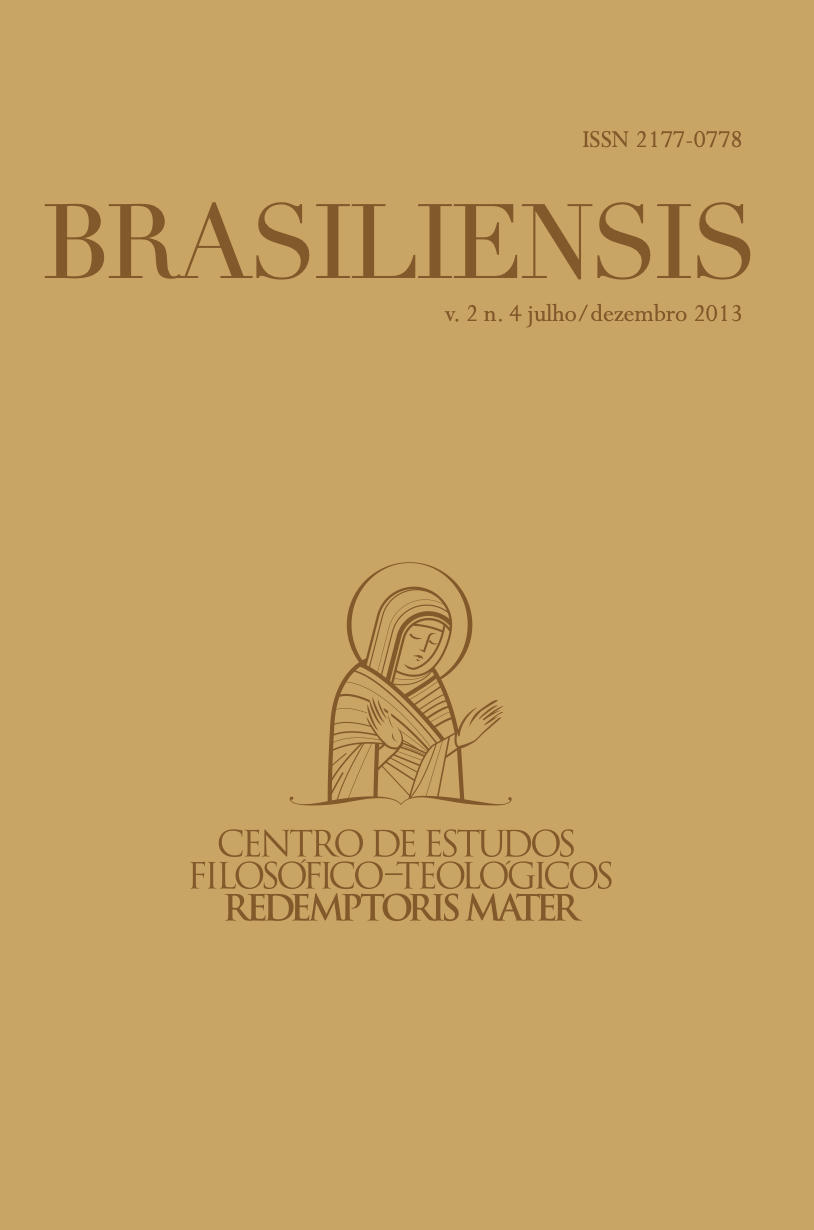La Aqedah y el Getsemaní a la cristología de Juan
Conteúdo do artigo principal
Resumo
En este artículo, estudiaremos un extracto del texto del Génesis (Gn 22) a la luz de las tradiciones targúmicas, estableciendo un paralelismo entre los eventos de la Aqedah y del Getsemaní, especialmente con relación a los personajes de Isaac y Jesucristo. Los textos utilizados fueron el TM (Texto Masorético) y la LXX (Septuaginta), considerando elementos de la tradición circundante a la época. Partiendo del problema de la datación de los Targumin, la primera parte del artículo se centrará en el análisis del Gn 22, teniendo como base el esquema de la Aqedah de Davies-Chilton. Al final de la primera parte, indicaremos las semejanzas de ese texto con el pasaje del Getsemaní, cuyos hallados indican correspondencia entre Isaac y Jesús. En la segunda parte, el análisis se concentrará sobre la LXX, cuyo objetivo será el de reunir otros indicios que refuerzen la citada correspondencia. Por fin, concluiremos con la presentación de los paralelos correspondientes, ya sean referentes a elementos lexicales, ya sean los pasajes de la Biblia.
Detalhes do artigo

Este trabalho está licenciado sob uma licença Creative Commons Attribution-NonCommercial-NoDerivatives 4.0 International License.
A licença Creative Commons Atribuição (CC BY) é a licença mais permissiva da Creative Commons. Ela permite que outros distribuam, remixem, adaptem e construam sobre sua obra, inclusive para fins comerciais, desde que lhe atribuam o devido crédito pela criação original.
Como Citar
Referências
BLOCH, R. “Note méthodologique pour l’étude de la littérature rabbinique”,
RSR 43 (1955).
BOVON, F. L’Évangile selon Saint Luc 19,28 – 24,53, v. 4, Genève: Labor
et Fides, 2009.
BOYER, L. La Bible et l’Évangile. Le sens de l’Écriture: du Dieu qui parle au
Dieu fait homme. LD 8, París: Editions Du Cerf, 1958.
DALY, R. “The Soteriological significance of the sacrifice of Isaac”, CBQ 39
(1977), p. 65-75.
DAVIES, P. R. – CHILTON, B. “The Aqedah: A Revised Tradition History”,
CBQ 40 (1978).
DELITZSCH, F. J. Novum Testamentum Hebraice. London, 1937.
DI LUCCIO, P. The Quelle and the Targums. Righteousness in the Sermons
on the Mount/Plain. AnBib 175, Roma 2009.
DíEZ MACHO, A. Neophyti 1. Targum Palestinense Ms de la Biblioteca
Vaticana, v. 1, Madrid 1968-1978.
______. “Targum y Nuevo Testamento”, en Mélanges E. Tisserant. StT 231
(1964), p. 153-185.
ECO, U. A Theory of Semiotics and Philosophy of Language. Bloomington:
Indiana University Press, 1984.
______. “Dictionary vs. Encyclopedia”, Enciclopedic Dictionary of Semiotics
SEBEOK, T. (Ed.), v. 1, Berlín 1994.
______. Lector in Fabula. Barcelona: Lumen, 1987.
______. The Limits of Interpretation. Bloomington: Indiana University Press,
ETHERIDGE, J. W. The Targums of Onkelos and Jonathan Ben Uzziel
on the Pentateuch with the fragments of the Jerusalem Targum. New York: KTAV, 1968.
FITZMYER, J. A. El Evangelio según Lucas, v. 2, Madrid: Cristiandad, 1986. ______. “The Study of the Aramaic Background of the New Testament” in The
Semitic Background of the New Testament. Grand Rapids: Eerdmans, 1997.
GARCíA MARTíNEZ, F. “Testi di Qumran”, Letteratura giudaica
intertestamentaria. ARANDA PÉREZ, G. – GARCíA MARTíNEZ F. – PÉREZ FERNÁNDEZ, M. (Ed.), Brescia 1998.
GARCíA MARTíNEZ F.; TIGCHELAAR E.J.C. (ed.) – VAN DER
HERBERT, A.S. Qumran Cave 11, v. 2, Oxford 1998.
HAIMAN, J. “Dictionaries and Encyclopedias”, Lingua 50 (1980). HATCH, E. – REDPATH, A. A Concordance to the Septuagint and the
other Greek Versions of the Old Testament. Oxford 1897-1906.
HEINEMANN, J. “Early Halakhah in the Palestinian Targumim”, JJS 25
(1974), p. 114-122.
HUIZENGA, L. The New Isaac: Tradition and Intertextuality in the Gospel
of Mathew. Leiben: Brill, 2009.
KESSLER, E. Bound by the Bible. Jews, Christians and the Sacrifice of Isaac.
Cambridge 2004.
KUNDERT, L. Die Opferung/Bindung Isaaks, v. 1, WMANT, Neukirchener 1998. LE DÉAUT, R. “Targumic Literature and New Testament Interpretation”,
Biblical Theology Bulletin 4 (1974), p. 243-289.
______. “The Current State of Targumic Studies”, BTB 4/1 (1974). LEVINE, E. “Neofiti 1: A Study of Exodus 15”, Bib 54 (1973).
MANNS, F. “Rabbinic Literature as a Historical Source for the Study of the
Gospels Background”, SBFLA 52 (2002), p. 217-246.
MILIK, J. T. Dix ans de découvertes dans le Désert de Juda. París 1957. MUÑOZ LEÓN, D. “El rostro nuevo del Pentateuco en el Targum. Reflejos
en el Nuevo Testamento”, SBFLA 49 (1999).
MURAOKA, T. A Greek–English Lexicon of the Septuagint. Louvain– Paris–Walpole, MA 2009,
NEUDECKER, R. I vari volti del Dio unico. Cristiani ed ebrei in dialogo,
Genova 1990.
NEUHAUS, D. “L’idéologie judéo-chrétienne et le dialogue juifs-chrétiens”,
RSR 85 (1997), p. 249-276.
REMAUD, M. Vangelo e Tradizione Rabbinica, CSB 47, Bologna 2005. RODRíGUEZ CARMONA, A. “Tradición targúmica y tradición
evangélica”, EstBib 48 (1990), p. 335-349.
SOKOLOFF, M. The Targum to Job from Qumran Cave XI. Ramt Gan 1974. VERMES, G.“New Light on the Sacrifice of Isaac from 4Q225”, JJS 47 (1996). ______. Scripture and Tradition in Judaism. Haggadic Studies by Geza
Vermes, Studia post-Biblica 4, Leiden 1973.
VICENT, R. La fiesta judía de las Cabañas (Sukkot). Interpretaciones
Midrásicas en la Biblia y en el Judaísmo Antiguo, BibMid 17; Estella 1995.
VOLTAGGIO, F. G. La oración de los padres y las madres de Israel.
Investigación en el Targum del Pentateuco. La antigua tradición judía y los orígenes del Cristianismo. BibMid 33; Estella 2010.

